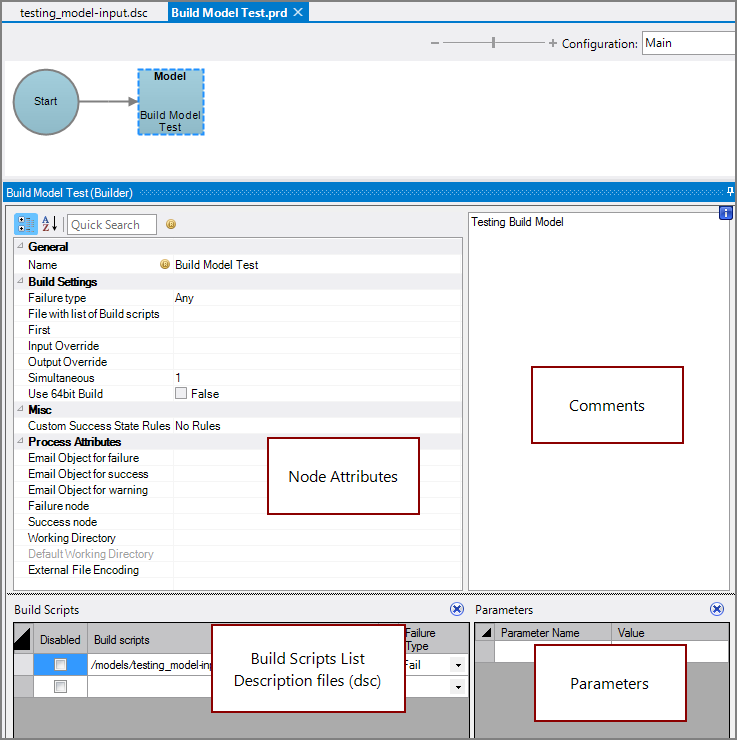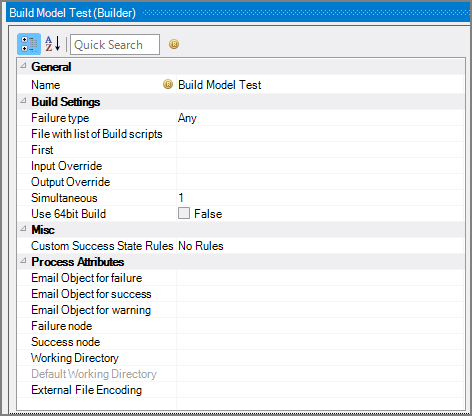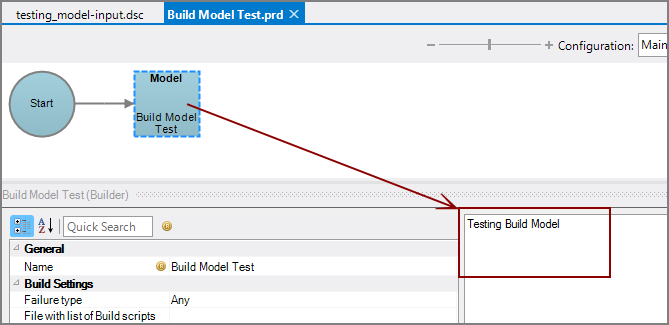A Build Model node is a Production process node that runs the Builder application to create one or more classic models as prescribed by the attributes. This was previously called a Builder node and is labeled Builder in the underlying script.
![]()
The Build Model node has ![]() four panes where you set attributes.
four panes where you set attributes.
You set attributes for the Build Model node in the ![]() node attributes pane.
node attributes pane.
| Attribute | Description |
|---|---|
| Name | Specify a descriptive name for the node. Lower case names maximize usage of the available space. |
| Failure type | Specify how to handle a Builder node failure in one or more defined Build scripts:
|
| File with list of Build scripts (Required if no Build Scripts attribute is set) |
Specify a text file that contains the names of each Build Description file. List the name of each Build script file on a separate line. To select the file, use the browse button (...) that appears when you click in the empty File with list of build Scripts box. This attribute and the Build Scripts attribute are mutually exclusive. |
| First | Define the number of records to process. Enter a number that sets the maximum number of records to process. NOTE: A script-level Production parameter is acceptable here, which might aid in testing. |
| Input Override | Define the path to a file used to override the input file specified in the Build Description file. |
| Output Override | Define the path to a file used to override the output file specified in the Build Description file. |
| Simultaneous | Define the maximum number of Builder Description files to process at the same time:
|
| Use 64bit Build | Indicate use of the 64-bit version of Builder. The default is 32-bit. |
| Custom Success State Rules |
Opens the |
| Email Object for failure |
Select a predefined mailing list to send an email to if the node fails. The pull-down list is populated with items that can be found in Project Settings > Mailing Lists > Email Templates. |
| Email Object for success |
Select a predefined mailing list to send an email to if the node succeeds. The pull-down list is populated with items that can be found in Project Settings > Mailing Lists > Email Templates. |
| Email Object for warning |
Select a predefined mailing list to send an email to if the node generates a warning. The pull-down list is populated with items that can be found in Project Settings > Mailing Lists > Email Templates. |
| Failure node | Select the next node upon failure. The pull-down list contains all nodes that are on the Task Flow. |
| Success node | Select the next node upon successful completion. The next node automatically populates if a connecting line is set on the Task Flow. The pull-down list contains all nodes that are on the Task Flow. |
| Working Directory |
Specifies the directory in which this node runs. If left blank, the Default Working Directory attribute that is set in the Start Control Node is used. When running a script, Production sets the working directory for the child process to the directory that contains the script, unless the node specifies a different directory. See Start Control Node. |
| Default Working Directory |
Displays the Default Working Directory that is set the the Start Control Node. If a Default Working Directory is not specified, this attribute is blank. Applies to all nodes. See Start Control Node. |
| External File Encoding |
Select the format for the node input files. If this attribute is blank, Workbench attempts to detect the type of encoding. This attribute is also used when saving log files. The encoding might need to be adjusted when using data with high bit Latin-1 characters or Unicode characters. |
Each node has an area where you can enter comments.
It is a DI best practice to enter a note for every node in a Production script. These notes can help you or a coworker understand the intent of the node and troubleshoot issues in the future.
![]() Build Model node with comments
Build Model node with comments
Specify one or more Build Description files in the lower-left ![]() Build Scripts pane.
Build Scripts pane.
The Build Scripts attribute is required if no File with list of Build scripts attribute is set.
The Build Scripts attribute supports additional control attributes for more detailed control of settings per file than if using the File with list of Build scripts attribute:
- Disabled—Disables specific Build scripts, which is useful for debugging. The default is no.
- Failure Type—Specifies how to handle an individual Build Description file failure: Fail, Never, or Warning. The default is Fail.
The Build Scripts and the File with list of Build scripts attributes are mutually exclusive.
Define parameters for this node in the lower-right ![]() Parameters panel.
Parameters panel.
NOTE: Node-level parameters are available only for the current node.
See Parameters in Production for more information.
See Build cBase Process Node for the Spectre build engine.





